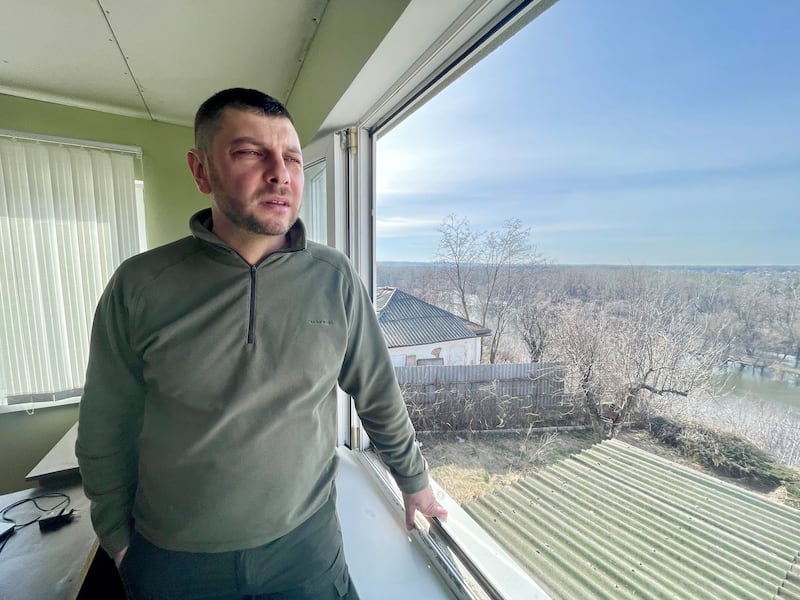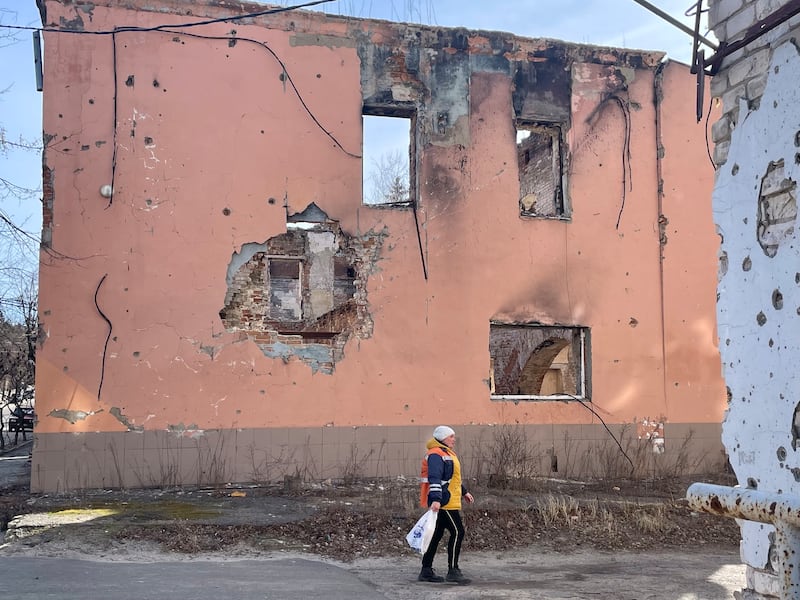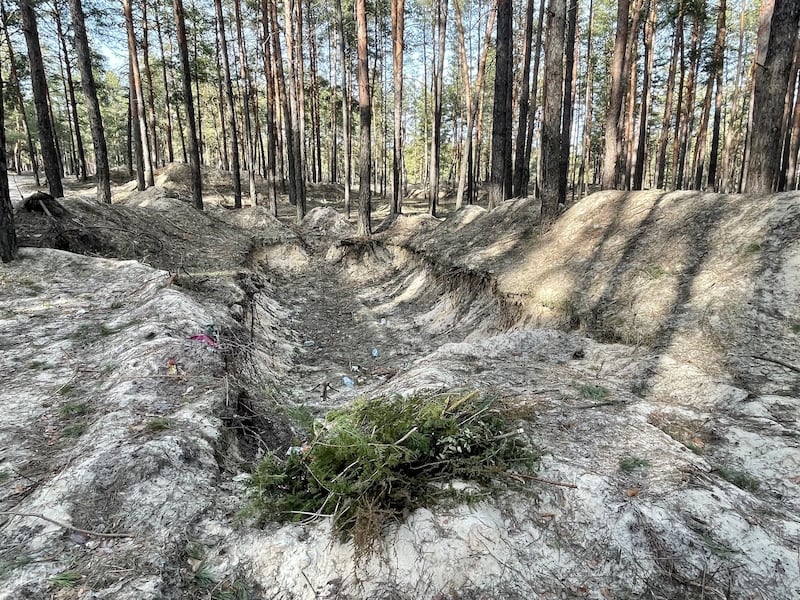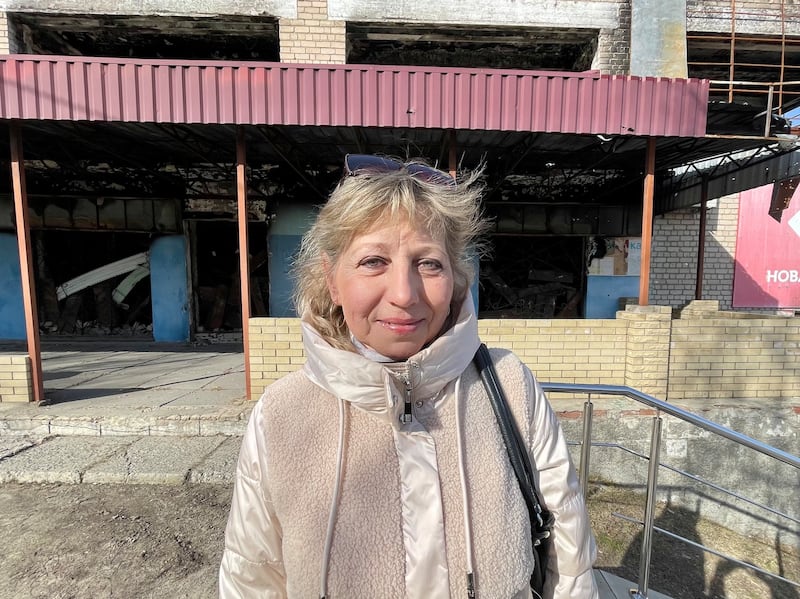Ukraine’s president celebrated the liberation of Izium in September 2022 by raising the nation’s blue-and-yellow banner over its main square, but he was not the first Volodymyr Zelenskiy to return to the battle-scarred and traumatised eastern town.
His namesake – a local activist and volunteer – had come home a couple of days earlier, to no national acclaim but to many handshakes and hugs from neighbours whom he feared might not have survived five months of brutal Russian occupation.
Two years after Russia’s invasion force took full control of Izium, on April 1st, 2022, Zelenskiy says his town is only slowly recovering from an ordeal that left behind thousands of damaged buildings, several torture chambers and mass graves, and residents fearful of further attack and suspicious of collaborators in their midst.
“It was terrible to see so much destruction in the place that I grew up,” Zelenskiy says of his return to Izium with other volunteers who had evacuated residents amid shelling and air strikes as Russia besieged the town during March 2022.
RM Block
“We went first to see the people who we were most worried about. The people who had helped us and had been out of contact for a long time. We arrived with water and food, because there was no power in much of the town so the water system didn’t work and people had no phone or online contact with the outside world,” he adds.
“The Russians lied to people, saying they had taken Kharkiv [Ukraine’s second city, 120km from Izium], that Kyiv was about to fall and Ukraine was basically finished. They were saying ‘Don’t worry guys, you’ll be with Russia forever,’” Zelenskiy recalls of the occupiers’ propaganda effort, which included publication of their own newspaper to fill the information vacuum in the town.

“When people saw vehicles coming into Izium marked with a cross, they didn’t know what it meant. They had seen the [Russian military symbols] Z and V and O, but they didn’t know who these guys with crosses were. Then they realised they were ours. They had waited for Ukraine to come back, but they still couldn’t believe it.”
Not all locals expected, or even wanted, Ukraine to retake Izium, however.
Ukraine has opened more than 6,600 criminal cases nationwide against people suspected of collaborating with Russia, including hundreds in Kharkiv region and a few dozen in Izium. The statute covers offences ranging from spreading Russian propaganda to working for the occupation forces to revealing the location of Ukrainian military sites, and punishment runs from a fine up to a possible 15 years in prison.
One prominent local pro-Moscow politician has been charged, in absentia, for showing Russian forces a back route into Izium that helped them bypass its defences.
“Pro-Russian parties were strong in Izium before the full-scale war. Almost half of the people voted for them, and most of those people are still here,” Zelenskiy says.
Kharkiv investigators discovered 28 torture chambers in deoccupied parts of the region, including at least 10 in Izium. The Russians set them up in a police station, a kindergarten, a sports centre, a medical clinic and in other buildings
“Many of those who stayed really thought that Ukraine wouldn’t come back. And some are angry now that, sooner or later, they will probably have to answer for what they did during occupation. That has a big influence on the mood of the town,” he adds.
“And many people who we had high hopes for have left for Europe. So now, those who don’t feel strongly either way are probably in the majority. They’re kind of ‘grey’,” he says, choosing the same term that Ukrainians use for no man’s land at the front line.
He says many of those who remained in Izium under Moscow rule could be called “zhduny” – which translates as those who “waited” for the Russians – or opportunists.

But many others were scared or unable to leave, or simply hid their patriotic feelings for Ukraine and hoped for the best. Even those who in some way helped the occupiers may have done so under extreme duress, in a town where the Russian gun was the law, disappearances were common, and torture and executions took place.
“Of course, plenty of right-thinking people have come back, and some stayed here as well and stayed quiet. They had their reasons for staying,” says Zelenskiy, who moved to western Ukraine when further evacuations from Izium became impossible.
“One of our tasks has been to help the town reintegrate smoothly into Ukraine, including for those people here who wanted Russia to come. We are tolerant,” he says of his non-governmental organisation Virnyi Napryam (The Right Direction).
Local officials estimate that more than 1,000 people were killed or died during fighting for Izium and its five-month occupation. Some were hit during intense shelling and air strikes, and weaker and older residents could not survive when power and water supplies failed, food and medicines became scarce, and healthcare collapsed.
“When we came back after liberation, some people were starving here,” says Maksym Strelnyk, deputy head of the military administration that runs Izium.

“Before the Russians fled, they imposed a 24-hour curfew. No one was allowed to leave their home or the basement where they were sheltering. So if they didn’t have some reserves of food put away then they were facing starvation,” he adds.
“People were buried right here,” he says, pointing to the grass verge outside a council building in the town centre. “People were killed by shelling in the street or in their yard, and had to be buried wherever possible by friends or family or neighbours. It was horrendous.”
Liberation revealed some of the horrors visited on Izium during intense fighting for and the occupation of a town that was a transport junction in Kharkiv region, and could have opened up a route for the Russians to the important Kyiv-controlled cities of Slovyansk and Kramatorsk in neighbouring Donetsk province.
In a pine forest on the edge of town, mass graves were found to contain the remains of 449 civilians. Most had died from injuries inflicted by shelling, but some had their hands tied and gunshot wounds to the head. Severe damage to the extremities of some bodies indicated torture. In one grave were the bodies of 22 Ukrainian soldiers, all of whom had been shot in the head.

Kharkiv investigators have discovered 28 torture chambers in deoccupied parts of the region, including at least 10 in Izium. The Russians set them up in a police station, a kindergarten, a sports centre, a medical clinic and in other buildings. Survivors have given accounts of being beaten, raped, waterboarded and subjected to electric shocks.
“We expect justice. There were mass graves here. The Russians wanted to hide their crimes,” Strelnyk says.
“Friends of mine were buried there, in those graves. I asked them to leave Izium with me, but they said ‘no, we’ll stay’. If I had stayed, I would have been there too. So I want those who killed them to be punished. And I hope – with the help of western partners – that we will do this.”
As Strelnyk speaks, a few dozen, mostly elderly locals wait nearby to ask him about compensation for damaged housing and other financial concerns.
Mass graves contained the remains of 449 civilians. Most died from injuries inflicted by shelling, but some had their hands tied and gunshot wounds to the head. Severe damage to the extremities of some bodies indicates torture
An engineering hub in Soviet times, Izium’s economy has been in the doldrums for decades. Full-scale war has almost killed it entirely, making life even tougher for the 25,000 or so people now living here – half as many as before 2022 but double the number here during occupation – and making reconstruction even harder to afford.
An estimated 80 per cent of Izium’s buildings were destroyed or damaged, including several schools and its main hospital, and bridges over the Donets river were among the major infrastructure that was flattened; Strelnyk puts the cost for reconstruction of the town at more than $3 billion (€2.8 billion).
“My old school was destroyed. I couldn’t go there for a long time because it was too hard to see it. There was a feeling of horror and pain. I know so many people who died here,” says Marina Kovtun, who used to work in the local administration.

“Our house was more or less okay, given that houses at the end our street were totally destroyed. I remember we were sheltering in the basement when they dropped a bomb on our district and the explosion was just terrible. I still get shivers when I think of the Russian planes flying overhead,” she recalls.
“It’s still hard now, but I think things are getting better. The parks and squares and buildings are being repaired as much as possible… People are coming back and places are reopening. I think more and more people will return,” she adds. “It was the right decision to come back. After all, it’s our Izium – we can’t abandon it.”
Russia’s daily attacks on Kharkiv region continue to shake people’s confidence in the future. Heavy fighting has raged for months near Kupiansk, 70km northeast of Izium, and missile strikes have pounded the province’s power grid in recent days. One person was injured when explosive drones hit a school in Izium on Wednesday.
Zelenskiy wants to run community projects with a particular focus on Izium’s youth, to help turn his hometown into a place where people stay and make a life and which, in time, will even draw tourists to a rolling, riverside landscape that is a pleasant rarity in the flatlands of eastern Ukraine.
“One of our tasks is to make people feel more positive about life here, to realise that we will win and that we’ve probably already been through the worst – we lost our homes, were scattered all over the place, but now we’re back and that’s good,” he says.
“It’s a difficult picture. But I think we’ll piece it together properly.”
- Sign up for push alerts and have the best news, analysis and comment delivered directly to your phone
- Find The Irish Times on WhatsApp and stay up to date
- Our In The News podcast is now published daily - Find the latest episode here






















